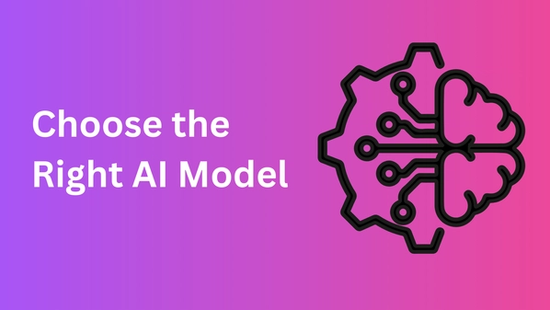
Choosing the Right AI Model for Your Task: A Guide to Large Language Models (LLMs) in 2025
Published: 3/5/2025
Introduction
Large Language Models (LLMs) have become indispensable across industries, powering applications from creative writing to technical problem-solving. With so many models available, selecting the right one is key to achieving efficiency, accuracy, and cost-effectiveness. This guide will help you navigate the LLM landscape in 2025 and choose the best model for your specific needs.
What Are LLMs?
LLMs are AI models trained on massive datasets to understand and generate natural language. Utilizing transformer architectures, they excel in various tasks such as writing, translation, summarization, and reasoning. Some of the most notable LLMs in 2025 include:
- GPT-4.5 (OpenAI) – High-performance but relatively expensive.
- Claude 3.7 Sonnet (Anthropic) – Strong reasoning and ethical AI, moderately priced.
- Gemini 2.0 Pro (Google) – Powerful multimodal capabilities, premium cost.
- DeepSeek-R1 – Excellent for STEM applications, cost-efficient.
- Qwen 2.5 Max – Strong analytical power at a budget-friendly price.
- Llama 3.1 (Meta) – Open-source and free to use, requires self-hosting.
Selecting the right model depends on your specific task and resource constraints.
Step 1: Define Your Task
Different LLMs excel at different tasks. Here's a breakdown of the best models for various use cases:
Creative Writing (Stories, Marketing Copy)
- GPT-4.5 – Fluent, creative, and great for marketing (expensive).
- Claude 3.7 Sonnet – Produces natural, engaging narratives (moderate cost).
- Gemini 2.0 Pro – Integrates visuals into content creation (premium pricing).
- Qwen 2.5 Max – Cost-effective and strong in creativity.
- Grok 3 – Ensures factual consistency for marketing copy (moderate cost).
Question Answering & Research
- DeepSeek-R1 – Strong in STEM-related queries and reasoning (cost-efficient).
- Claude 3.7 Sonnet – Handles complex questions with precision (moderate cost).
- Grok 3 – Real-time web and X search integration (moderate cost).
- Gemini 2.0 Pro – Leverages Google's vast data resources (premium pricing).
Text Summarization
- Claude 3.7 Sonnet – Handles long-context documents effectively (moderate cost).
- GPT-4.5 – Efficient at generating structured summaries (expensive).
- Gemini 2.0 Pro – Supports summarizing long reports (up to 1M tokens, premium pricing).
- Qwen 2.5 Max – Reliable performance with a 128K-token window (affordable).
Technical Tasks (Coding, Math, Analysis)
- Claude 3.7 Sonnet – Excels in software engineering tasks (moderate cost).
- GPT-4.5 – Strong in programming and debugging (expensive).
- Grok 3 – High-performance computing and LiveCodeBench leader (moderate cost).
- DeepSeek-R1 & Qwen 2.5 Max – Top choices for programming (cost-efficient).
- Llama 3.1 70B – A powerful open-source alternative (free, requires setup).
Conversational AI (Chatbots, Customer Support)
- Claude 3.7 Sonnet – Context-aware and engaging conversations (moderate cost).
- GPT-4.5 – Seamless, natural interactions (expensive).
- Gemini 2.0 Flash – Fast, multimodal responses (premium pricing).
- Grok 3 – Integrates real-time data from X (moderate cost).
Step 2: Consider Model Size & Resources
- Larger models (e.g., GPT-4.5, Gemini 2.0 Pro) offer higher performance but require more computing power, increasing costs.
- Smaller models (e.g., Mistral 7B, OpenAI o1-mini) are cost-efficient and ideal for lightweight applications.
Step 3: Evaluate Knowledge & Training Data
- General-purpose models (e.g., GPT-4.5, Llama 3.1) cover broad topics.
- Domain-specific models (e.g., DeepSeek-R1 for math, Qwen 2.5 for analytics) excel in specialized areas.
- Real-time data access (e.g., Grok 3, Gemini 2.0 Pro) ensures the most current information.
Step 4: Balance Accuracy & Ethics
- Claude 3.7 Sonnet emphasizes AI safety and minimal hallucinations.
- GPT-4.5 balances accuracy with creativity.
- Open-source options (Llama 3.1, Mistral) offer transparency but may require fine-tuning.
Step 5: Test & Iterate
No single model fits all scenarios. Test multiple LLMs for quality, speed, and relevance to determine the best fit for your needs.
Notable LLMs in 2025 (At a Glance)
If you're looking for a quick overview of the best models in 2025, here's how they compare:
- GPT-4.5: High accuracy, reduced hallucinations – Expensive
- Claude 3.7 Sonnet: Hybrid reasoning, software engineering – Moderate cost
- Gemini 2.0 Pro: Tool use, image & speech generation – Premium pricing
- DeepSeek-R1: Strong in STEM, math benchmarks – Cost-efficient
- Qwen 2.5 Max: High analytical power, budget-friendly – Affordable
- Grok 3: Real-time knowledge, coding – Moderate cost
- Llama 3.1 70B: Open-source, multilingual – Free (self-hosting required)
Final Thoughts
Selecting the right LLM starts with clearly defining your task, considering resources, and testing for accuracy. Whether you need creative content, technical precision, or real-time data, the 2025 LLMs offer powerful options.
Want to explore multiple LLMs?
Test different models efficiently on PlutoChat and find the perfect AI assistant for your needs!